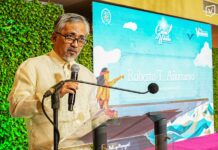UNLIKE the monumental election of popes, we don’t hear someone proclaiming “Habemus Papam” when a University Rector is chosen. Neither is there white or black smoke to signal if someone has been elected or not. But just like the election of a Pope, the election process in choosing a Rector involves a closed-door meeting by the Dominican friars, where they nominate a candidate to be confirmed in Rome, a confirmation which the entire UST community awaits with eager anticipation.
Similar to the Conclave of Cardinals that selects the Pope, the Dominican fathers in the UST Priory, together with the other Dominican fathers teaching in UST, hold a convocation where they nominate three candidates. The meeting is called by the Vice Rector, who automatically becomes the acting Rector after the incumbent’s term ends.
The priests, after invoking the Holy Spirit, place the name of their candidate in a paper which is then balloted. The person who gets the majority vote, which is one half of the total members present plus one, becomes an official candidate. The process is repeated until three names are chosen. If no one gets a majority vote after three rounds, they choose the two names with the highest votes as the candidates.
The chosen candidates are required to accept their nominations obediently and with humility. They cannot object.
The statutes of the Dominican order also prohibit anyone to present himself as a candidate for Rector as this is considered a taboo.
After the University Vice Chancellor approves the three candidates, he presents the names, arranged in alphabetical order, to the Academic Senate, composed of the University Vice Chancellor (the head of the Dominican province in the Philippines), the University Vice Rector, the Vice Rectors of the different departments in UST, deans, and the secretary general. They scrutinize the merits of the candidates and rank them. If anyone from the Academic Senate is nominated, he inhibits himself from the meeting.
The University Vice Chancellor then transmits the names to the Board of Trustees, composed of the vice chancellor, the Vice Rector, the Vice Rector for finance, and the secretary general. They in turn, deliberate and select one candidate.
The name and credentials of the candidate are then submitted to the Master of the Order, who at present is Rev. Fr. Carlos Aspiros, O.P. The master endorses the chosen candidate to the Vatican’s Sacred Congregation for Catholic Education and Seminaries, for the final evaluation. The council then declares the candidate as “nihil obstat”, Latin for “nothing obstructs” or “there is no obstacle” and gives the name back to the Master of the Order, who makes the official appointment. Beginning from the nominations, the whole process usually takes three to four months. No appointment has ever been questioned by the Vatican since the screening at the local level makes sure that the candidates are qualified and capable to lead the University.
According to former College of Education professor Josefina Lim Pe’s “The University of Santo Tomas in the 20th Century,” a written historical account of UST, since 1611, only the Dominican Province of the Most Holy Rosary of the Philippines decided who would assume the rectorship. It was not until 1936 that the current election process, was introduced to include other officials of the University. Jordan Mari S. de Leon and Paolo S. Mariano










